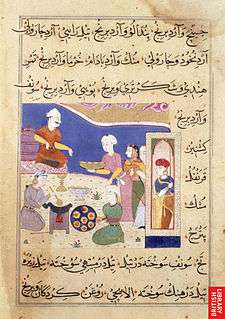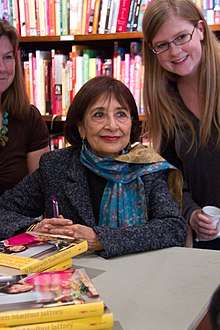Indian cookbooks
Indian cookbooks are cookbooks written in India, or about Indian cooking. Some of the oldest cookbooks were written in India[1] Indian cooking varies regionally and has evolved over the centururies due to various influences. Vegetarianism has made a significant impact on Indian cooking.[2] Spices play a major role in Indian cooking.[3]
Early Indian Texts
Sushruta Samhita written between 2nd and 4th century BC, is a medical text that prescribes seasonal foods and flavours.
Saint Andal, a 7th-8th century Tamil Alvar saint of lord Thirumal, mentions a dish called Akkaravadisal in the Nachiyar Thirumozhi, in that she "wishes to devote lord Thirumal 100 brimming pots of akkaravadisal". The dish is still prepared for lord Thirumal in South Indian temples during the Tamil month of Marghazi(November-December), and is a known dish amongst most Tamil Brahmin families.[6][7]
Manasollasa, is one of the earliest texts compiled during the rule of Chalukya king Someshvara III in the 1130AD. It includes several recipes including "iddarika" thought to refer to idli, although there is disagreement about that. It has been suggested that Vaddaradhane, the Kannada text of Jain Acharya Sivakoti written in 920 AD, the mention of iddalige may be the earliest mention of Idali.[8]
Indic and Islamic cookbooks of Sultanate and Mughal Period

The Ni'matnama is a fifteenth-century collection of the recipes during the rule of Sultan of Mandu (Madhya Pradesh), Ghiyath Shahi, and his son and successor, Nasir Shah. It contains recipes for cooking as well as providing remedies and aphrodisiacs.[9] It also includes a sections on the preparation of betel leaves.[10]
Soopa Shastra, (1508 A.D.) written by Mangarasa III, a follower of Jainism, is exclusively vegetarian. The ingredients and cooking methods are given detail, and even the types of utensils and ovens needed are mentioned. King Mangarasa III belonged to the Chengalvu dynasty, and was under the suzerainty of Hoysala kings The first chapter describes thirty five breads, sweets and snacks, now mostly obsolete. The second chapter describes drinks, salty, sour and sweet in taste. Third chapter discusses nine types of payasa (kheer), eight types of cooked rice and 24 mixed rice dishes. The remaining three chapters include recipes for 20 dishes with eggplant, 16 dishes with jackfruit and 25e dishes made with raw bananas (plantains) and banana flowers. The last chapter contains recipes using bamboo shoots and myrobalan.[11] Even though it was composed during the rule of a Jain ruler, some of the vegetarian ingredients mentioned, such as onions, are regarded inappropriate for strict Jains.
In the chapter, Pishtakadhyaya, food items made with flour like rotti, mandige, garige, dose, iddali have been mentioned. It shopuld be noted that inncient Kannada poetry has used ‘rotika’ even earlier.[12] It is notable that the word Soopa is used in the same sense as the English term "soup".
The first book of Ain-i-Akbari (the third volume of the Akbarnama), written in 1590, gives several recipes, mainly those prevailing among the Mughal elite.[13]
Bhojana Kutuhala written by Raghunatha[14] between 1675 and 1700 discusses numerous ingredients and dishes then prevailing in the Maharashtra region.
Alwan-e-Nemat 17th-century, 101 recipes from the kitchen of Mughal emperor Jahangir [15][16]
Nuskha-e-Shahjahani, Pilaf (seasoned rice) recipes[17] from Shah Jahan's’s reign[18]
British Period
The British rule saw publication of several cookbooks, some intended for the British elite, others for locals, often in languages like Gujarati, bangla and Hindi. These include
- Pak-Shastra, 1878, Gujarati
- Culinary Jotting for Madras, 1891, later republished as Vwyer's Indian Cookery
- Mistanna Pak, 1904, Bengali
- Bengal Sweets, Haldar 1921.[19][20]
- Recipes-Of-All-Nations 1923, Countess Morphy, has an Indian section which mentions gulgula, Halwa and khoa etc.
- Pak Chandrika, Maniram Sharma 1929, Hindi
- Indian Cookery, Veeraswamy 1930s, who established the oldest existing Indian restaurant in England.
- Vrahad Pak Vigyan, Pandit Nrisinghram, 1939, Hindi
- Navin-Pak shastra
The Bengali sweets, including the Rasgulla emerged in this period.[21][22] Also "English Vegetables" (cabbage, cauliflower, tomato, turnip etc.) as they were at one time termed, became common.[23]
Vrahad Pak Vigyan has a special section on "Angreji" (i.e. English) cooking that includes biscuits, breads ("double-roti"), tomato and mushroom dishes in addition to meat/egg (termed "non-vegetarian" in India) dishes.
During freedom struggle and After Indian Independence

- Dalda Cookbook, 1949? [24] An illustrated best seller published in English, Hindi, Tamil and Bengali by Dalda Advisory Service. Its Pakistani counterpart is still being published.
- Modern Cookery Vol I, Thangam Philip, 1946[25]
- Indian Cooking, Savitri Chawdhary 1954, written by an Indian housewife migrating to England.[26]
- Pak Ratnakar, 1958
The large scale migration of families from Punjab and Singh led to popularity of Samosa,[27] Nan, Chhole, Karachi Halwa etc. With migration of South Indians to North, South Indian dishes became common in the North.
Internationalization of Indian cooking
With large scale migration of Indians to North America, and with arrival of international influence in India, a new set of cookbook authors emerged.
- An Invitation to Indian Cooking, Madhur Jaffrey, (1973),[28] who has since then written a series of popular cook books.
- Classic Indian Cooking, by Julie Sahni, 1980, she is the founder of the Indian Cooking School, established 1973 in New York City.[29]
- Lord Krishna's Cuisine: The Art of Indian Vegetarian Cooking Hardcover, Yamuna Devi, 1987
With the advent of TV and the internet, new food authors have emerged in the past few decades. There is significant international influence because International travel has become common. These include
- The Pleasures of Vegetarian Cooking, Tarla Dalal, 1974, followed by 170 other cookbook titles.
See also
- Cuisine
- Culinary art
- Food preparation
- Food writing
- Recipe
- Wikipedia:Cookbook
References
- Dasgupta, Bhaskar (2016-04-01). "The world's first cookbooks". Live Mint. Retrieved 2018-09-03.
- Brehaut, Laura (2017-05-03). "Chitra Agrawal's South Indian home cooking classics are light, fresh and vibrant". National Post. Retrieved 2018-09-03.
- Love, Laura (2017-05-03). "The Yarm dad whose new Indian cookbook is already a bestseller". gazettelive. Retrieved 2018-09-03.
- K.T. Achaya (2003). The Story of Our Food. Orient Blackswan. p. 85. ISBN 978-81-7371-293-7.
- Edward Farnworth (2008). Handbook of Fermented Functional Foods, 2nd Edition. Routledge. pp. 15–16. ISBN 978-1-4200-5328-9.
- https://essenceoflife-sm.blogspot.com/2019/01/akkaravadisal-recipe-akkara-adisil.html
- https://www.thehindu.com/features/friday-review/history-and-culture/Ramanujas-respect-for-women/article14564084.ece
- Palecanda, Lakshmi (2015-07-18). "Kitchen chronicles". Deccan Herald. Retrieved 2018-09-03.
- "The culinary adventures of Ghiyath Shah, the sultan of Malwa". The Indian Express. 2016-05-13. Retrieved 2018-09-03.
- Titley, Norah M. (2004-11-30). The Ni'matnama Manuscript of the Sultans of Mandu: The Sultan's Book of Delights. Routledge. ISBN 9781134268078.
- SOOPA SHASTRA OF MANGARASA: CULINARY TRADITIONS OF MEDIEVAL KARNATAKA (1508 A.D.)
- Did soup flow from Karnataka?, Ratnadeep Banerji, Press Information Bureau, 25-March, 2015
- India Historical Recipes British-Raj Akbar-period
- Gode, P. K. (1941). "A Topical Analysis of the Bhojana-kutuhala, a Work on Dietetics, composed by Raghunatha — Between A. D. 1675 and 1700". Annals of the Bhandarkar Oriental Research Institute. 22 (3/4): 254–263. JSTOR 43975952.
- Durbar Entrees, SHEELA REDDY, Outlook, 15 OCTOBER 2001
- What did Shah Jahan have for dinner?, LABONITA GHOSH DNA India, 7 Mar 2009
- Husain, Salma (2007-01-01). Nuskha-E-Shahjahani. Rupa & Company. ISBN 9788129111364.
- A fabled cuisine, A.G. NOORANI, Frontline, Apr. 10-23, 2010
- Exploring the Romance of Bengali Sweets with J. Haldar, Itiriti
- Cooking Class: Lesson 32 by Yamuna Devi Nov 1, 1997, Lord Krsna's Cuisine, Volume-31 Number-06, Yamuna Devi Dasi
- 10 Popular Bengali Sweets: Beyond Rasgulla and Sandesh, Priya Chakraborty, NDTV Convergence, June 09, 2016
- "Rasogolla debate: West Bengal to stake claim to Rasogolla through GI route". The Indian Express. 2015-08-26. Retrieved 2018-09-03.
- Mukerji, Nitya Gopal (1901). Hand-book of Indian Agriculture. Thacker, Spink & Company.
- "Swatantra". Swatantra. 9 (1–26): 47. 1954.
- How to Make a National Cuisine: Cookbooks in Contemporary India, Arjun Appadurai, Comparative Studies in Society and History, Vol. 30, No. 1 (Jan., 1988), pp. 3-24
- A Memory of my Mother Savitri Devi Chowdhary 1919 - 1996, Shakun Banfield née Chowdhary,
- Of samosa and kachori Sumit Paul, The Hindu, DECEMBER 05, 2016
- Dutta, Kunal (2014-10-05). "Madhur Jaffrey: The doyenne of curry is back... but tikka's not". The Independent. Retrieved 2018-09-03.
- Q. & A. With Julie Sahni (Round Three) THE NEW YORK TIMES APRIL 30, 2010
External links
| Wikibooks Cookbook has a recipe/module on |
- The Wikibooks' open-content cookbook anyone can edit
- Feeding America at Michigan State University Digital Library—a collection of influential early American cookbooks, including a large number of books specializing in immigrant cuisine
- Menus and Cookbooks at The New York Public Library

